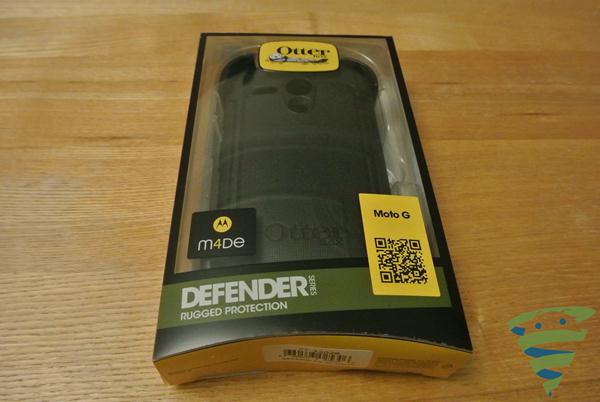 One name generally stands out when it comes to ultimate mobile protection: OtterBox. It’s hard to go past the steadfast quality of OtterBox cases, particularly when you are considering getting the best protection for your smartphone. Despite the Moto G being one of the best selling phones that Motorola has ever produced in recent years, there are still lack of cases that are capable of fully protecting the device. Enter the OtterBox Defender Series for Motorola Moto G.
One name generally stands out when it comes to ultimate mobile protection: OtterBox. It’s hard to go past the steadfast quality of OtterBox cases, particularly when you are considering getting the best protection for your smartphone. Despite the Moto G being one of the best selling phones that Motorola has ever produced in recent years, there are still lack of cases that are capable of fully protecting the device. Enter the OtterBox Defender Series for Motorola Moto G.
What’s in the box
 If you have never heard of the OtterBox Defender Series, the premise of the product is to be the best possible protection for a device in any given environment. It’s dust proof, water proof, Â and drop proof. Just by looking at it, you’d think it were also tank proof (definitely unconfirmed).
If you have never heard of the OtterBox Defender Series, the premise of the product is to be the best possible protection for a device in any given environment. It’s dust proof, water proof, Â and drop proof. Just by looking at it, you’d think it were also tank proof (definitely unconfirmed).
 Inside the humble little box, you will find the Defender along with a belt harness that can be mounted on all manner of things. There aren’t any peripheral things like screen protectors or screen cleaning cloths included because you won’t be needing them; a plastic film encases the screen to stop errant debris being forced into the case, making for a relatively airtight seal.
Inside the humble little box, you will find the Defender along with a belt harness that can be mounted on all manner of things. There aren’t any peripheral things like screen protectors or screen cleaning cloths included because you won’t be needing them; a plastic film encases the screen to stop errant debris being forced into the case, making for a relatively airtight seal.
 The Defender is made up of three pieces; two of these make up the hard plastic inner case which can be likened to a skeleton protecting inner organs (i.e. your previous phone). A silicon outer layer goes on top of this skeleton, giving your Moto G the shock proofing it needs. The process of opening the case can be a little fiddly, but once inside, you really do get the sense that your Moto G can now face any adversity. We have the Black version of the case here today, but the case can also be had in Glacier, Key Lime, Wild Orchid, and Hornet variants.
The Defender is made up of three pieces; two of these make up the hard plastic inner case which can be likened to a skeleton protecting inner organs (i.e. your previous phone). A silicon outer layer goes on top of this skeleton, giving your Moto G the shock proofing it needs. The process of opening the case can be a little fiddly, but once inside, you really do get the sense that your Moto G can now face any adversity. We have the Black version of the case here today, but the case can also be had in Glacier, Key Lime, Wild Orchid, and Hornet variants.
How does it perform?
 As with the previous entries in the Defender Series, the Moto G version does exactly what Otterbox does best, and that’s protecting your phone. The inner plastic frame forms an extremely snug fit around the Moto G, allowing for no free space inside. I found it a little frustrating trying to get it open initially, but perseverance is the key here.
As with the previous entries in the Defender Series, the Moto G version does exactly what Otterbox does best, and that’s protecting your phone. The inner plastic frame forms an extremely snug fit around the Moto G, allowing for no free space inside. I found it a little frustrating trying to get it open initially, but perseverance is the key here.
 Once the silicon cover goes over, each accessible port on your device (bar the microphone on the bottom and the back speaker) are covered with a flap to prevent any dust or dirt getting in. The hold and volume buttons are also encased within the silicon case, and I had been concerned that the case would ruin the tactile feel of the Moto G’s normally crisp buttons. To my pleasant surprise, the buttons remained impressively tactile; dampened of course, but much better than I had expected.
Once the silicon cover goes over, each accessible port on your device (bar the microphone on the bottom and the back speaker) are covered with a flap to prevent any dust or dirt getting in. The hold and volume buttons are also encased within the silicon case, and I had been concerned that the case would ruin the tactile feel of the Moto G’s normally crisp buttons. To my pleasant surprise, the buttons remained impressively tactile; dampened of course, but much better than I had expected.
Over my test period of several weeks, my device suffered absolutely no damage and the silicon case looks exactly the same as the day I put the case on, save for some specs of dust. As you might expect, there was a little build up of dust in specific parts of the case including the microphone and speaker port, as well as the slit where the front facing camera and ear speaker are left open. In general, the Defender engulfs the Moto G and makes it look fairly ambiguous, which is good or bad depending on how you look at it; all I know is I was asked why I had such a big case for my iPhone quite a few times.
 The harness has been a staple for the Defender Series and its inclusion with the Moto G version is no surprise. The construction is basically identical the previous versions, including the swivelling clip. The harness is made from hard plastic to withstand the rigours of outside activities. I’m personally not big on using the harness myself, but it’s a great little accessory with great durability.
The harness has been a staple for the Defender Series and its inclusion with the Moto G version is no surprise. The construction is basically identical the previous versions, including the swivelling clip. The harness is made from hard plastic to withstand the rigours of outside activities. I’m personally not big on using the harness myself, but it’s a great little accessory with great durability.
What I like about the Defender Series case
 I like that the Defender case is protective; I know that sounds almost like a moot point given OtterBox’s reputation, but it’s one thing to say it, but it’s another to excel at it, which the Defender does. If you’re the type of person who drops your device frequently, or just needs a little more security in case something happens, the Defender has those credentials written all over it.
I like that the Defender case is protective; I know that sounds almost like a moot point given OtterBox’s reputation, but it’s one thing to say it, but it’s another to excel at it, which the Defender does. If you’re the type of person who drops your device frequently, or just needs a little more security in case something happens, the Defender has those credentials written all over it.
 As I mentioned earlier, I was quite afraid that the case would impair the Moto G’s button tactility, however I’m hugely impressed that it hasn’t really taken away from that at all. The same can’t be said for the Commuter case which we reviewed earlier, as the silicon buttons seemed to absorb too much of the force to create a nice feeling button press. So yes: you could say that the Defender pushes my buttons.
As I mentioned earlier, I was quite afraid that the case would impair the Moto G’s button tactility, however I’m hugely impressed that it hasn’t really taken away from that at all. The same can’t be said for the Commuter case which we reviewed earlier, as the silicon buttons seemed to absorb too much of the force to create a nice feeling button press. So yes: you could say that the Defender pushes my buttons.
What I don’t like about the Defender Series case
 While the Defender is a supremely protective case, that naturally comes at somewhat of a cost. Because the edges around the screen are raised so high and ends right where the screen is, I found that the screen near those edges became a little more difficult to use. Case in point for me has been while I try to swipe words on my screen and I want to hit the letter “p”; because the edge is so close to the screen and the fact that fingers are round, it would actually take a few attempts to properly spell the word I was intending to. Sure it might be a small peeve, but since it happens on a daily basis, it’s more than a little frustrating.
While the Defender is a supremely protective case, that naturally comes at somewhat of a cost. Because the edges around the screen are raised so high and ends right where the screen is, I found that the screen near those edges became a little more difficult to use. Case in point for me has been while I try to swipe words on my screen and I want to hit the letter “p”; because the edge is so close to the screen and the fact that fingers are round, it would actually take a few attempts to properly spell the word I was intending to. Sure it might be a small peeve, but since it happens on a daily basis, it’s more than a little frustrating.
Final Thoughts
 It’s hard not to give the Defender Series top marks as a smartphone case; if you’re in the market for something super-heavy duty to protect your Moto G, you can’t go past the Defender. Sure it has its peeves and downsides, but if your concern is protecting your phone, you can be sure that the Defender has the same concerns in mind. And for $49.95, that’s a small price to pay for peace of mind. That said, if you’re looking for something almost as protective with a little more freedom, take a look at the OtterBox Commuter instead (read our review here).
It’s hard not to give the Defender Series top marks as a smartphone case; if you’re in the market for something super-heavy duty to protect your Moto G, you can’t go past the Defender. Sure it has its peeves and downsides, but if your concern is protecting your phone, you can be sure that the Defender has the same concerns in mind. And for $49.95, that’s a small price to pay for peace of mind. That said, if you’re looking for something almost as protective with a little more freedom, take a look at the OtterBox Commuter instead (read our review here).
If you’re interested in picking up the OtterBox Defender Series Case for Motorola Moto G, you can visit its product page here, or to take a look at OtterBox’s other products, you can check out their full website here.
Gallery of Photos

























